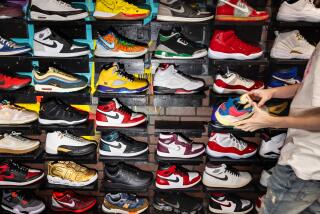Watch Out for Dangled Karat of Fool’s Gold
- Share via
“It’s a very good price,” said the jewelry merchant, eager to sell a 28-inch, 10-karat gold chain for $735. “This is solid gold. It would be twice that in the stores, but they’re retail. I’m wholesale.”
Such claims are hardly uncommon. Many jewelers’ signs say “Wholesale to the public.” Department stores regularly offer jewelry at 30% off, 50% off, 70% off, implying high value and much higher “regular” prices.
Unfortunately, jewelry “is what we call a credence good,” says George Schulman, staff attorney for the Federal Trade Commission in Los Angeles. “It’s not possible for an ordinary citizen to judge the truth of the claims.” Indeed, says Los Angeles jeweler Henry Yamada, “jewelry is basically a matter of trust.”
Such trust made last year’s U.S. jewelry sales an estimated $18.5 billion at retail--40% sold through department stores and catalogues, and 60%, or $11.1 billion, at jewelry stores, according to trade magazine Jewelers’ Circular-Keystone. After diamonds, “karat gold” jewelry accounts for almost a quarter of the jewelers’ sales. Gold rings bring in more than half that money, says the Gold Information Center in New York, a promotion arm of gold producers, but earrings account for one in three purchases.
‘Karat Gold’ Preferred
Few people even understand the terms. In the trade, “karat gold” is today’s preferred term for what the consumer might call “real” or “genuine” gold--that is, contains gold. “Solid gold,” another colloquialism, has nothing to do with purity but simply means gold jewelry that’s not hollow.
“Gold-filled” actually means gold-covered, overlaid “with a sheet about one-twentieth the weight of the entire metal,” says Joel Windman, general counsel at the Jewelers Vigilance Committee in New York. “Gold-electroplated,” “gold wash” and “gold flash” involve an even thinner application of gold. These hybrids have “no intrinsic value,” says Gerry Hansen, director of the Jewelry Industry Council in New York, “because there’s not enough gold left when they’re melted.”
Karat gold comes in gradations, each karat representing a degree of purity (not weight) equal to 1/24 gold in a mixture of metals. Thus, 24-karat is pure gold and very soft. According to the Gold Information Center, more than 85% of the gold jewelry sold is 14-karat, which is 14/24 or 58% gold. The rest is split between 18-karat (75% gold, and more popular in Europe) and 10-karat (42% gold).
“Credence” time starts with these designations, usually stamped on the jewelry. It’s just the manufacturer’s affidavit, unproved and not immediately provable. There’s an acid test, which involves making a scratch mark with the item on a slate-like material, and another scratch with a strip of gold of known purity, running over them with nitric acid and comparing the resultant colors. Even then, “it’s only an indication that something’s approximately 14 karat,” says North Hollywood jeweler Cosmo Altobelli.
Fire Assay Test
“To be really sure,” says Schulman, “you’d have to destroy the item by cutting a piece off and melting it down.” This is called a “fire assay;” the impurities burn off and the pure gold is left, measurable. Few consumers would do it just to test a purchase.
There is no requirement that gold be stamped, but “the law says if it is marked, the manufacturer has to put his trademark there as well,” says Windman. That way, if the mark misrepresents the purity--and some of the “14K” sold is rumored to be only eight or nine karat--the manufacturer can be accountable.
There are also FTC “guides” specific to jewelry, most focused on how vendors represent products. These define the proper composition of various grades of karat and plated gold, and spell out the proper meanings of terms such as “perfect,” “real” and “genuine,” mostly as applied to gemstones.
The industry offers some protection, mainly through the Jewelers Vigilance Committee, an industry-supported group whose function is “to advance ethical practices.” Its support is somewhat limited: Its 2,500 members represent only one in 20 of all U.S. retailers and manufacturers. So are its weapons: Windman’s office fields complaints and tests suspicious goods, but attacks unethical practices mostly with letters threatening to take their findings to the FTC or to local prosecutors--a threat that’s often persuasive.
There’s always self-protection, of course, focused less on the goods than the source. The industry urges choosing “someone in the mainstream,” “somebody you know is good” or a “reputable dealer”--in itself a difficult judgment.
There are some tips and more warnings offered. The industry suggests patronizing people who have been in business some time, although that neither rules out longtime hustlers nor admits decent newcomers. One could beware one-day, one-time sales in hotels. Such “traveling road shows,” says Windman, “are traveling for a reason: Where are you going to find them tomorrow when you have a complaint?”
Some suggest thinking twice about jewelers who permit no returns, because “all sales final” also leaves the customer without recourse if he or she is dissatisfied. This is a common sign at arcades, and not uncommon even at “mainstream” jewelers, who worry, says Laurie Hudson, spokesman for the American Gem Society, “that people might want it to wear to one event or might replace a gem.” They might also just want to cement a sale.
The reddest flag is the perpetual sale: “Some people have a sale every week,” says Altobelli. Some department stores offer 30% off and 50% off so regularly that one might ask which is truly the “regular” price, and jewelers that advertise a constant “70% off!” bring up the question what exactly it’s off.
Then there are all those retail operations claiming to be wholesalers and promising to sell wholesale to the public: “The public begins to wonder who really is the wholesaler when everyone is striking up the same song,” says jeweler Yamada. They could advertise a lower markup or claim to have low prices, but they cannot change the definition of wholesale. Wholesaling is selling to a retailer for resale to the public. Selling anything “to the public” is by law and definition retailing.


